Accounting Network
The RiverWare workspace shows the layout of the physical system of your model. See General Workspace Features in User Interface for details on the workspace. In an accounting model, there is secondary workspace called the Accounting View which shows the accounting network in the model. The Accounting View provides a graphical layout of the Accounting network, including objects, accounts, links, and supplies.
Note: If objects with accounts and supplies are exported/imported, the supplies and accounts can also be exported/imported. See Exporting and Importing Objects in User Interface for details on the options available to import or export objects with their accounts and supplies.
The following section describes how to access the accounting view, describes features of the Accounting View, workspace options, display properties, and graphical account aggregation.
Accessing the Accounting View
If accounting is enabled, the Accounting View option is displayed in the Workspace View button menu as shown in Figure 3.2. It is also available from the View menu.
Figure 3.2 Accessing the Accounting view

The accounting view provides a representation of the physical objects, as well as, the accounts on those objects. The first time the user switches from the Simulation View to the Accounting View, RiverWare uses the location of the objects to create a default layout in the accounting view. This default layout is similar to the Simulation View but typically, the user must rearrange objects and accounts to get a realistic and usable layout.
• Click on the Workspace view option menu shown in Figure 3.2 and switch to the Accounting View.
Features of the Accounting View of the Workspace
Accounts in the accounting view are displayed in the object territory of its parent simulation object, providing a spatial association of the account with its simulation object. An object territory is a rectangular box with the object icon and name in the upper left corner. Icons representing the accounts on that simulation object are displayed within the territory in a single row. The position of the accounts in the territory are configured through a drag and drop operation; however, RiverWare provides an initial default ordering, as shown in Figure 3.3 and Figure 3.4.
Figure 3.3
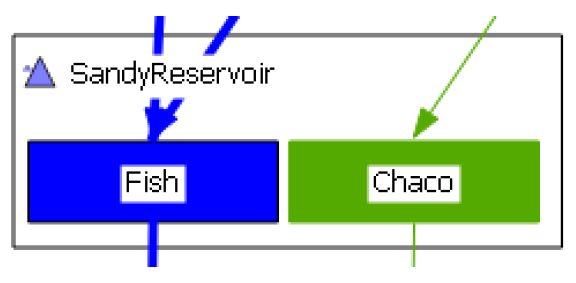
Figure 3.4
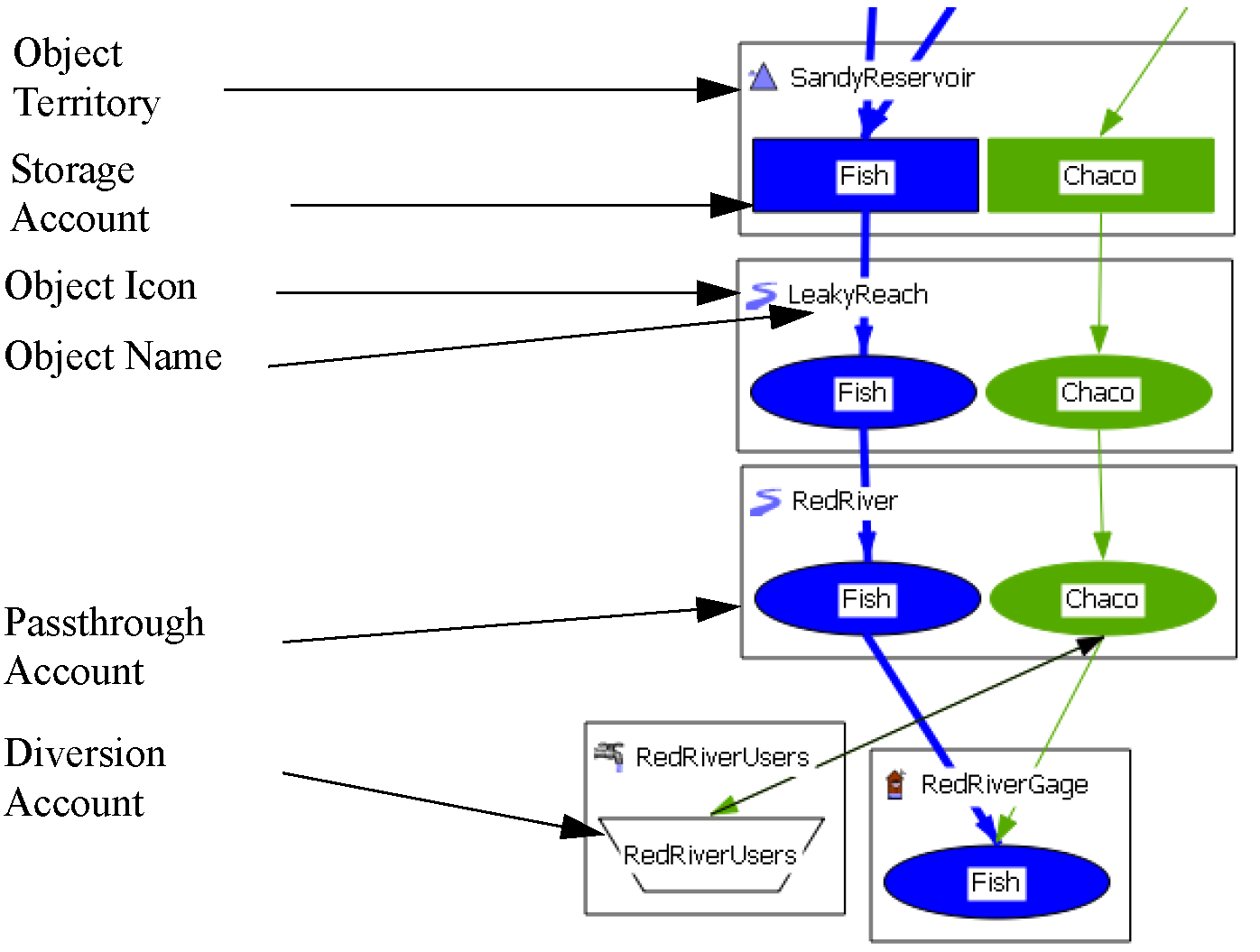
The accounting view can represent the four account types: storage accounts, passthrough accounts, diversion accounts, and instream flow accounts. Storage accounts are represented by rectangular icons, pass through accounts are represented by elliptical icons, diversion accounts are represented by an isosceles trapezoid, and instream flow accounts are represented by a pointed rectangle. The account name is presented within its icon; however, if the account name is too long to fit within its account icon, the name is truncated and marked with an asterisk (*). Supplies are represented by a line between two accounts with the directional supply-demand relationship represented by an arrowhead on the demand-side of the supply. Supplies between accounts on the same object (transfers) are represented by a curved line.
The position of the object territories is configured through a drag drop operation just as icons can be moved in the simulation view. The first time the accounting view is activated for a model, RiverWare will attempt to position the accounts in a meaningful way; however, some manual tuning will be necessary particularly in areas of divergence or convergence. The user can force the network to layout again by right-clicking the workspace, and selecting Layout Network. The positions of the objects in the simulation and accounting views are not coupled and can be move independently.
Accounting View Navigation Techniques
The Accounting View workspace can be used for model building and navigation similar to the main Simulation View workspace. This includes the construction of simulation objects and links, not just accounts and supplies. The user can add objects, create accounts on objects, create links and supplies, etc. Context sensitive menus are activated by the right mouse button. In the object territory, right-clicking gives the user options to create links, open the object, and add accounts among other features. Right-clicking an account gives the user the option to open the account, configure the account and add supplies to the account.
Figure 3.5

Tool Tips in the Accounting View
Mousing over a component in the accounting view will provide the name of that component as a tooltip. Place the mouse on the component and leave it there until the name appears, after approximately one second.
Information shown includes the name and the following user-defined attributes for accounts and supplies:
• Account attribute: Water Owner
• Account attribute: Water Type
• Supply attribute: Release Type
• Supply attribute: Destination Type
Figure 3.6
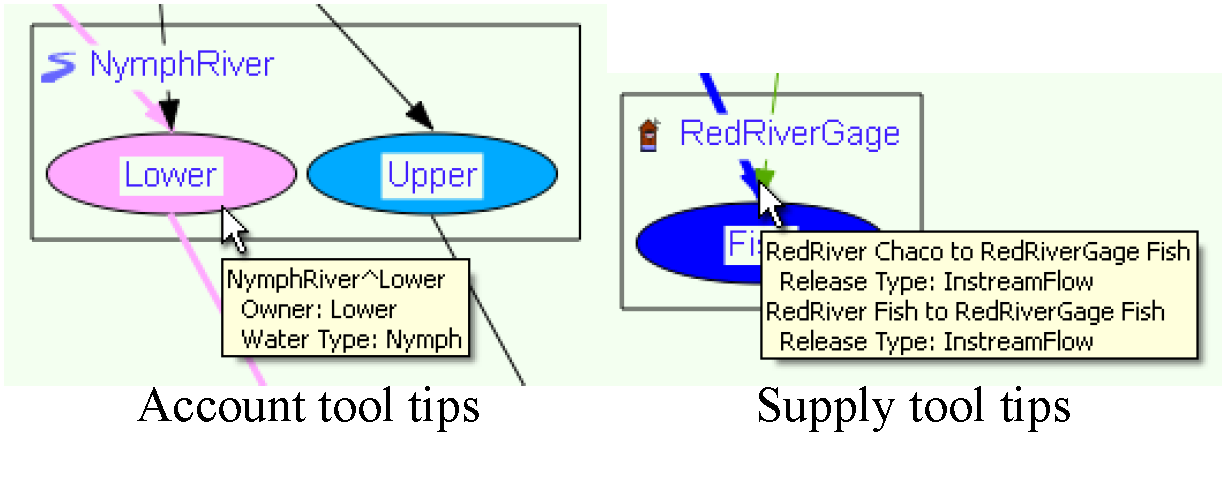
Also the information is shown in the workspace status bar (lower left corner). This can be useful because as long as the mouse is over the item, the name is shown in the status bar. Tool tips only show the name for a few second.The status line includes all relevant attributes, regardless of whether or not those attributes are defined in the model file (edited in the Accounting System Configuration dialog). For attributes without definitions, a value of “NONE” is shown, e.g. (“Destination Type: NONE”).

Display Properties
The appearance of links, objects, accounts, and supplies on the workspace can be manipulated using the Display Group Editor. The dialog is accessed by:
• Selecting Workspace, then Display Group Properties
or
• Right-clicking with the mouse on the workspace. This will bring up a window with the option to select Display Group Properties.
The Display Group Editor provides the ability to create groups of links, groups of objects, and if accounting is enabled, groups of supplies and groups of accounts. The display properties (including color, line width, shading, etc.) and the membership of a group can be changed by double-clicking that group. The membership of the groups need not be mutually exclusive. The groups are prioritized. For example, if two link groups contain the same link, the group highest in the list (lowest priority number) will be used to set the display properties of that link. Display groups can be enabled and disabled by selecting the check mark in the Enabled column.
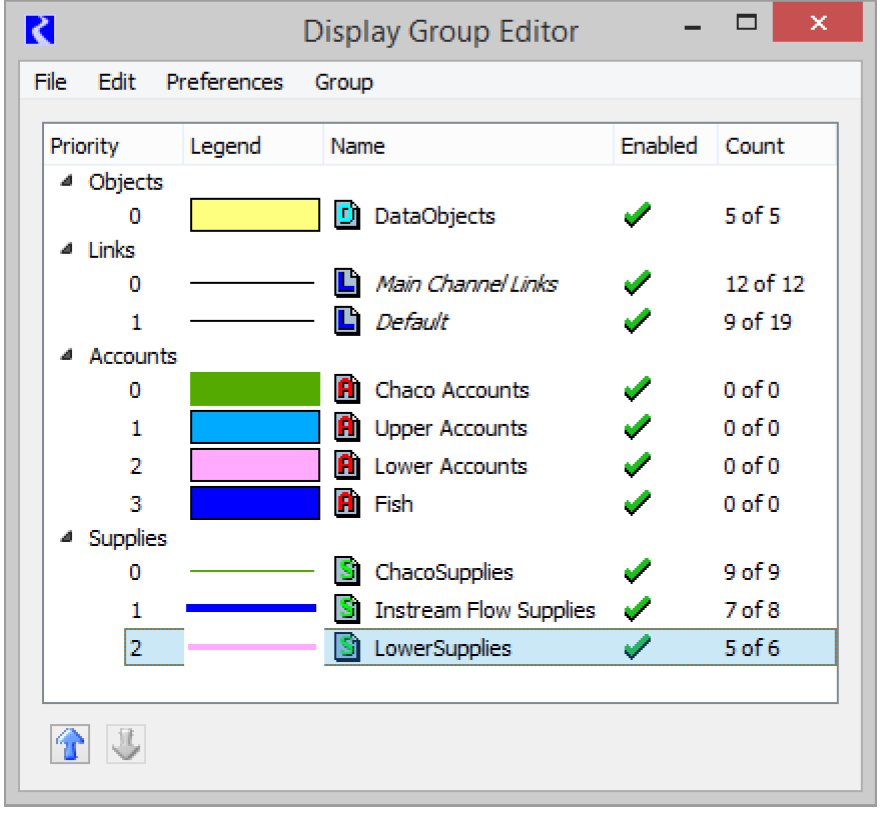
• Right-click on the workspace and select Display Group Properties. The Account Group Display Configuration dialog opens.
Figure 3.7
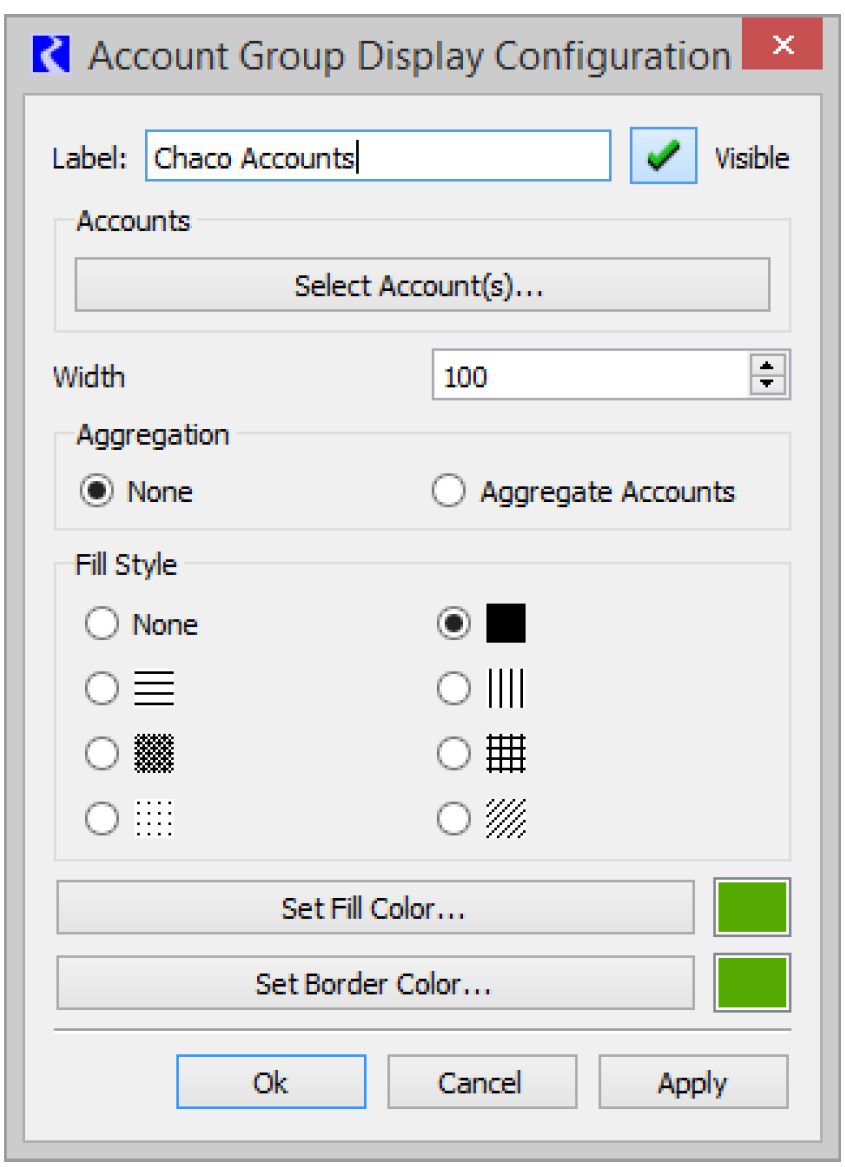
Account Groups
Add a new Account Group through the Group, then Add Account Group. Double-clicking an account group entry will bring up the Account Display Group Configuration dialog.
The membership of the group and the fill style, fill color, account width, account aggregation, and border color of the group members can be set with this dialog. The membership of Accounts within the group is controlled by selecting the Select Account(s) button. The selection uses the standard Object/Slot/Account/ selector dialog and wild cards and filters can be used to select the appropriate accounts. An account can also be added to an Account Display Group by right-clicking the account on the workspace, mousing over Add to Account Group, and selecting the desired Account Display Group. If the account is already a member of an Account Display Group, this option will be replaced with Account Group Membership. Mousing over this option will show the display group to which the account belongs.
Supply Groups
Similar to the Account groups, Supply groups are used to control the appearance of supplies or accounting links.
Properties
The display properties of the accounts and supplies are configured through the display group editor. The display group editor allows users to define groups of objects and the display properties on those groups. The groups are prioritized, allowing an item to span multiple groups. The properties of the highest priority group containing an item will be used to draw the item. Configurable account display properties include the following:
• Border color. Color used to draw the outline of the account’s geometric representation.
• Fill Color. Color used to fill the area within the account’s geometric representation.
• Fill Style. Pattern used to fill the area with the account’s geometric representation (e.g., solid vs. a crosshatch pattern).
• Width. Width of the account’s geometric representation. The geometric representation will stretch to accommodate the account’s name up to this limit, at which point, the account name will be truncated. Hovering the mouse over the account will provide the full name.
• Visibility. Controls whether or not the account will be shown in the network.
• Aggregation. Built-in ability to aggregate the visual representation of one or more accounts.
Configurable supply display properties include:
• Line Color. Color used to draw the supply.
• Line Style. Style used to draw the supply (e.g., solid line vs. dashed line).
• Line Width. Width of the line.
• Visibility. Controls whether the supply will be shown in the network.
The user can also select to show the simulation links (e.g. Reservoir.Outflow to Reach.Inflow) on the Accounting View. This option is selected from the Display Group Editor dialog Preferences, then Show Links in Accounting View. Using link groups in the Display Group Editor, the links can be colored and the width can be changed to distinguish them from the accounting supplies. Showing the simulation links helps when building an accounting model to show which objects are connected to which other objects. This is useful because accounting supplies can only connect objects which are physically linked in the accounting system.
Graphical Account Aggregation
The account aggregation capability of the account display group provides functionality to group similar accounts to avoid clutter on the workspace. When accounts are aggregated, all the accounts in the aggregation will be represented by a single icon that looks like a stack of two accounts icons. This representation is labeled with the name of the display group that aggregated the accounts. A tooltip provides the names of all the accounts in the aggregation.
Revised: 01/05/2024